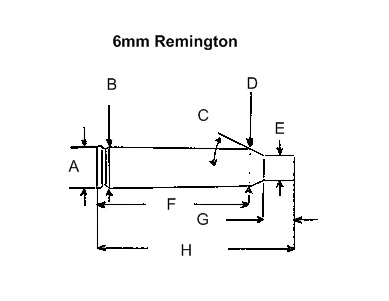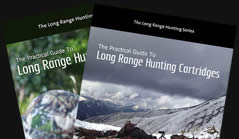6.5 Remington Magnum
History
The 6.5 Remington Magnum was introduced in 1966 for the Remington Model 600 short action rifle. The design concept was to produce two compact yet powerful cartridges for the equally compact M600 carbine which had been in production since 1964. The new cartridges consisted of the 6.5 and .350 Remington Magnum (see .350 Remington Magnum). Unfortunately the combination was for the most part, a complete failure, regardless of the cartridge’s performance.Remington used the standard 2.5” belted magnum cartridge design (7mm Rem Mag/ .264 Win Mag) shortened to 2.171” as the base for the two short magnums. It has been suggested that the 6.5 was supposed to deliver .270 Winchester ballistics from a more compact platform than was commonly available in the 1960’s. This is most likely true considering the similar marketing that was used to promote Remington’s more recent cartridge designs, the .260 and SAUM’s.
During the initial development phase, Remington ballisticians believed that the 6.5 Magnum could not utilize a 140 grain projectile in the short action magazine without cramping powder space and losing a great deal of velocity. Instead, the cartridge was loaded with a 120 grain Core-Lokt. To make the rifle compact, not only was the action/ magazine short, but also the barrel at just 18.5”. With the selected bullet weight of 120 grains, the 6.5 Remington Magnum was loaded to 2800fps. Naturally, consumers did not find favor with the 6.5.
Following the poor sales of the M600/6.5, Remington discontinued production of the M600 in 1967 and chambered the 6.5 Magnum in the slightly updated M660 (1968-71) which featured a 20” barrel. Remington also produced a limited number of M700 rifles (22” barrel) chambered for the 6.5. Regardless of the configuration, the 6.5 Remington Magnum still failed to excite hunters. The cartridge soon faded into history as yet another curiosity in the evolution of firearms and cartridges. Remington discontinued production of rifles chambered for this cartridge for several decades but in 2004, re-introduced the 6.5, perhaps simply for the sake of nostalgia, in the M673 Guide rifle which is available in limited numbers.
The 6.5 Remington Magnum cartridge is today recognized as one of the first short magnums proceeding the currently successful WSM and SAUM line of cartridges. Many of the original 1960’s rifles remain in circulation today.
During the 1980’s, many hunters used the Mauser M98 action for building 6.5 Remington Magnum caliber rifles due to the fact that the magazine length of the Mauser (unaltered) is far too short to fully utilize 2.5” cased cartridges. The 6.5/M98 combination was for many hunters, considered an optimum design.
Performance
Contrary to popular opinion, the 6.5 Remington Magnum is an incredibly efficient and effective case design. In 1966, the year of the cartridge’s introduction, hand loaders were able to obtain 3000fps with 120 grain bullets and 2800fps with 140 grain bullets - all from 18.5” barrels. The 20” barreled carbine produces slightly higher velocities but any increase in performance is unnoticeable in the field. From a 22” barrel, although no longer a carbine, the 6.5 gives exceptionally high velocity. Performance on game from the 18.5-20” barrels is identical to full power loads in both the Swede and .260 Remington.Remaining examples of the 18.5” and 20” barreled carbines have major qualities that are desirable for training youths however muzzle blast and excessive noise can be major detractors.
| Average hand loading velocities for 6.5 Rem Mag | ||
| Barrel length | 120 grain | 140 grain |
| 18.5” | 2990fps | 2800fps |
| 20” | 3050 | 2850 |
| 22” | 3120 | 2920 |
| 24” | 3200 | 3000 |
Oddly, performance of the 6.5 Rem Mag does not show a noticeable improvement in velocity with 140 grain bullets from custom medium length action rifles. Nevertheless, the longer seating depths do allow more flexibility with slow burning powders while the 24” barrels commonly seen on custom rifles tend to generate exceptionally high velocities. Performance from the rare 22” barreled M700 and 24” custom barrels is of the same level as the 6.5-06 and not too far behind the .264 Winchester Magnum. These velocities provide wide wounding on medium game out to ranges exceeding 350 yards resulting in very fast killing.
Factory Ammunition
Remington currently list the 120 grain Core-Lokt at 3210fps from a 24” test barrel. In the 18.5” carbine, velocities are between 2980 and 3000fps. For every inch of barrel added, the average gain in velocity with this load is right on 35fps. The 120 grain 6.5mm Core-Lokt is a unique bullet. Penetration is not deep at close to moderate ranges however the Core-Lokt pulverizes vitals, transforming them into a near liquid state. Shoulder muscles and bone are also totally destroyed in the process and on lighter medium sized game, the Core-Lokt produces either a small exit wound or comes to rest under the offside skin. Shots must be limited to broadside or angles which don’t require the bullet to traverse for long distances through rumenous fiber. The Core-Lokt has a poor BC and suffers immensely from wind drift but is still able to produce reasonably broad wounding out to 250 yards. This bullet is not well suited to heavily muscled or heavily boned game.Hand Loading
The 6.5 Remington Magnum gives optimum performance with powders in the 4350 range in carbine length barrels and 4831 in custom medium length action rifles with 24” barrels. Brass is readily available from Remington distributors. Factory rifles have a twist rate of 1:9 which is perfectly suited to 120-140 grain bullets.While projectiles like the 120 grain Nosler Ballistic Tip give exceptional results on light game, it has been very common for reloaders to use the 125 grain Nosler Partition in the 6.5 Remington Magnum. This is a sound projectile for lighter medium game, both violent yet reasonably deep penetrating.
The 6.5 Rem Mag is at no disadvantage when loaded with heavier projectiles which are capable of giving more consistent results over a wide range of body weights. The tradition of using a light 120 grain bullet was, as previously stated, an attempt to duplicate the .270 Winchester. From 18.5-20” barrels, the 6.5 Remington Magnum cannot duplicate the performance of the .270 Winchester in the field. The differences in wounding are quite obvious when carcasses are laid side by side for comparison. For this reason, it is far better to focus on optimizing consistency and in this regard, the 140 grain Hornady SST and 140 grain Partition are both without peer.
From longer barreled rifles, the 6.5 Rem Mag gives excellent results with the core bonded Scirocco, Accubond and InterBond 129 grain projectiles which can be launched at 3020fps (22” barrel) and (3100fps). These loads do indeed duplicate the performance of the .270 but with greater retained velocity and less wind drift. Performance with these bullets generally decreases (speed of killing) beyond 300 yards (2600fps) after which a softer projectile should be used. The short action Remington is not particularly well suited to the use of VLD projectiles but can utilize the 140 grain A-max with relative ease.
Closing Comments
The 6.5 Remington Magnum is a rare sight today. Those who use it tend to like it but it is a cartridge that needs chronographed load development for optimum results. This cartridge has mostly been superseded by the wildcat 6.5WSM however, putting the belted case head issue aside, there are great lessons to be learned from the internal case dimensions of the 6.5 Remington Magnum and its powder capacity to bore ratio. | Suggested loads: 6.5 Remington Magnum | Barrel length: 18.5 | |||||
| No | ID | Sectional Density | Ballistic Coefficient | Observed MV Fps | ME Ft-lb’s |
|
| 1 | FL | 120gr Core-Lokt | .246 | .323 | 3000 | 2398 |
| 2 | HL | 140gr SST 18.5” barrel | .287 | .520 | 2800 | 2437 |
| 3 | HL | 140gr SST 20” barrel | .287 | .520 | 2850 | 2525 |
| 4 | HL | 140gr SST 22” barrel | .287 | .520 | 2920 | 2634 |
| 5 | HL | 140gr SST 24” barrel | .287 | .520 | 3000 | 2797 |
| Suggested sight settings and bullet paths | |||||||||
| 1 | Yards | 100 | 150 | 260 | 298 | 325 | 350 | 375 | 400 |
| Bt. path | +3 | +3.6 | 0 | -3 | -5.7 | -8.7 | -12.2 | -16.2 | |
| 2 | Yards | 100 | 150 | 252 | 292 | 325 | 350 | 375 | 400 |
| Bt. path | +3 | +3.4 | 0 | -3 | -6.3 | -9.2 | -12.6 | -16.4 | |
| 3 | Yards | 100 | 150 | 258 | 298 | 325 | 350 | 375 | 400 |
| Bt. path | +3 | +3.5 | 0 | -3 | -5.6 | -8.3 | -11.6 | -15.2 | |
| 4 | Yards | 100 | 150 | 267 | 307 | 325 | 350 | 375 | 400 |
| Bt. path | +3 | +3.6 | 0 | -3 | -4.6 | -7.2 | -10.2 | -13.6 | |
| 5 | Yards | 100 | 150 | 276 | 318 | 325 | 350 | 375 | 400 |
| Bt. path | +3 | +3.7 | 0 | -3 | -3.7 | -6.1 | -8.8 | -12 | |
| No | At yards | 10mphXwind | Velocity | Ft-lb’s |
| 1 | 300 | 8.6 | 2220 | 1313 |
| 2 | 300 | 5.6 | 2321 | 1674 |
| 3 | 300 | 5.5 | 2365 | 1739 |
| 4 | 300 | 5.3 | 2428 | 1832 |
| 5 | 300 | 5.1 | 2499 | 1942 |

| Imperial | Metric | |
| A | .532 | 13.51 |
| B | .513 | 13.03 |
| C | 25deg | |
| D | .494 | 12.57 |
| E | .288 | 7.34 |
| F | 1.699 | 43.18 |
| G | .261 | 6.63 |
| H | 2.171 | 55.15 |
| Max Case | 2.171 | 55.15 |
| Trim length | 2.160 | 54.8 |
Discuss this article or ask a question on the forum here
Copyright © 2007-2017 Terminal Ballistics Research, Ballisticstudies.com
|
|||||||||
|
|||||||||
FOUND THIS ARTICLE HELPFUL?If you find the resources on this website to be valuable, we would be sincerely grateful if you would consider making a donation to help us cover the costs of the website and to assist us to continue our research and testing into the future. It doesn't matter whether your donation is big or small - it makes all the difference! |
|||||||||






